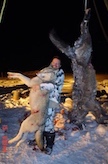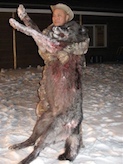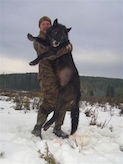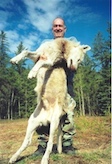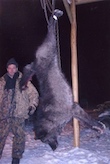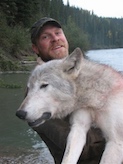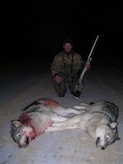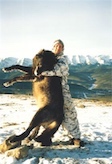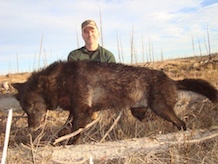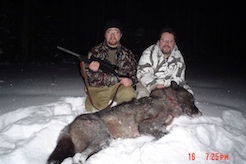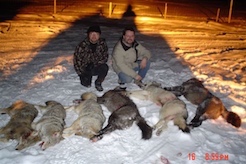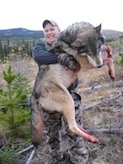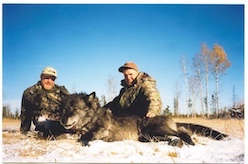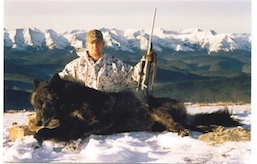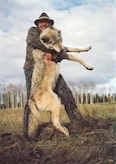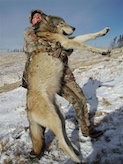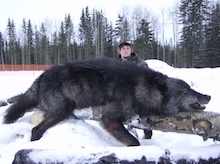Alberta Wolf Hunting
We personally guide Non-residents and resident hunters on trophy Alberta wolf hunting adventures. Winter is the best time to hunt over bait, call or track down a massive wolf. It will take patience and skill to get you in site of the ultimate predator the Alberta wolf pack. Read the stories below to some first hand Alberta wolf hunting.
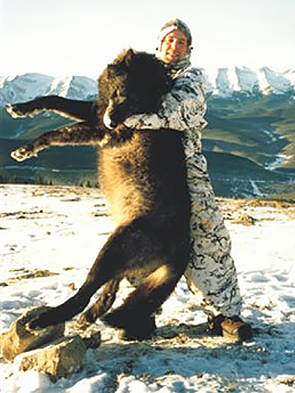
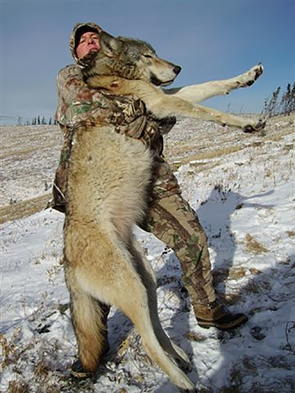
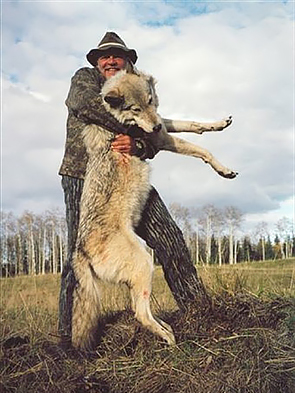
WALKIN’EM DOWN!!
By Chad Lenz
One of North America’s hardest trophies to take has to be a wolf. I’m not talking getting one incidentally on a hunt for something else; I am talking one on one, “emono emono” specifically on a hunt for wolves. I have been hunting and guiding most of my adult life and truly know how difficult it is to harvest a wolf. They are one of this continent’s top trophy animals in my books. There are a couple techniques however that will up your odds. The most common method is over bait, this will take many hours of waiting in a blind watching a food source in hopes that a wolf will come in to feed. This method is best done in winter during very cold weather and with good snow depth. Warm weather and lack of snow will really lessen your odds. This method works and is your best bet at taking a wolf. It won’t be easy, but it is tough for most people to sit all day, for many days, but very rewarding when the ghosts of the north woods appear in front of you for the opportunity of a life time. Next method is calling, unlike calling coyotes or other predators, wolf populations are lower and these are pack animals thus getting close enough for them to here the call is difficult. Wolves are also the king of killers and normally not as hungry as lesser predators and eat on there time thus calling not real successful. Calling however will work if you can get in close and undetected to hungry wolves, also realize wolves eat big so fawn beats work better than your typical dying rabbit calls. I must admit, there is not much in the natural world that can excite you like a pack of wolves running at you at full speed when calling works.
The hardest method physically can be the same way wolves are successful, running or walking down their prey. Conditions have to be right, you need snow for tracking but not too much or walking long distances will be too difficult. You need new soft snow to keep your noise down, a steady wind from the right direction, and most importantly fresh tracks. What you will need most is “desire” to walk possibly for many miles with out stopping and keep your senses on high alert every minute you are in pursuit. Physically and mentally this is the ultimate challenge.
Last fall I came upon a very fresh mule deer killed by wolves while jet boating the North Saskatchewan River in west central Alberta. I decided to build a blind along the banks and see if the pack would return to the kill. They did, but in the night after I was long back at camp sleeping. The next day I headed back up the river and found a new blanket of snow, the perfect conditions for tracking and hopefully walkin em down!! Wolves travel remarkable distances so I was prepared to walk as long as it took as long as conditions remained favorable. I tied the boat a mile or so upstream from the tracks in the direction they were headed, I figured I should cut the tracks up a cut line and save my self some miles. A couple miles up the cut in the direction of a large meadow that I had hunted in the past I cut their trail, I figured 5-6 wolves in the pack including two very large ones. They headed straight up the cut to the edge of the large meadow and the tracks seemed very fresh. It was a perfect morning; overcast but bright, no wind and right at freezing keeping the snow soft and quiet. Nearing the opening I started to get a “feeling” as the wolves turned west and separated leaving multiply trails, they seemed to be hunting again. I got ready taking my trusty .280 from my shoulder and carrying it in ready position, I was now still hunting, taking a step, waiting, watching, forcing myself to see and feel everything around me, I had that feeling. After a mile or so and nearing the end of the meadow I caught movement, I instinctually kneeled to the ground next to a large pine tree. He was moving towards me, he was big and black, like an apparition appearing from nothing he angled into the open at only 80yds. Then he stopped scening something he looked out into the meadow, looking for something, I slowly shouldered the rifle and found him in the centre of the scope. My movement caught his yellow eyes, his head turned, and they glared right through me as I squeezed the trigger. He went straight down from the shock of the 140 grain projectile penetrating both shoulders. All was still, nothing moved, I sat for a good 40 minutes waiting to see if his companions would come looking for their fallen comrade. Finally I stood and walked to the black beast lying motionless in the snow. I had done it; I had walked em down, one on one. After several minutes of admiration and some photos I decided the fallen beast was too heavy to carry back to the boat and skinned him before leaving the meadow. Packing my precious cargo into my daypack I headed back to the rivers edge. I had a surreal feeling the rest of the day and enjoyed the sights and sounds of the river as I floated back to camp. The next morning was a carbon copy of the day before; I decided to see if lightning would strike twice. Canus Lupus is a pack animal, and I have seen in the past, wolves go looking for the lost members. I was looking for a long shot and every gambler knows you can’t score big with out challenging the odds. I soon found myself back in the meadow, it was again very still and again I got that feeling. They had been back; their tracks revealed they had come looking for the big black. I moved out into the meadow and sat under a tree that I had used in past seasons to watch for whitetails. I had a good view 400yds in all directions; it wasn’t long maybe 10 minutes after settling into my hide that he appeared. I could hardly believe what was in plain site skirting the edge of the opening straight in front of my position, a very large light gray, almost white wolf. I had previously ranged his position and knew he was 406yds from were I sat. I slowly raised the rifle, braced it on my knee and turned the power up on the scope to 16 X. He filled the scope as I watched him move in and out of the edge, he turned straight at me, walked a few steps and turned broadside. I tried to hold back the shakes and control my breathing, the 400 yd dot was on the mark and I had control, at the recoil he vanished from sight. I stood and noticed a light figure lying in the grass, still not grasping what had transpired. As I approached the still mass it hit me, a bit shaky and overwhelmed, lightning had struck twice. I had killed wolves in the past but never like this, awesome mature males with perfect pelts and huge skulls. I couldn’t believe my luck, in 2 days I harvested two huge Alpha male wolves by walkin em down!!
KINGS OF THE WILDERNESS
By Don Anderson
Ask a group of Canadian hunters to name the animal that best represents the spirit of the wilderness, and you will usually get a narrow range of answers. By those who hunt the high peaks, bighorn sheep or mountain goats are often chosen. And those who hunt the western coastal ranges will usually tell you that the grizzly gets that honor. But those who hunt the dark forests that cover much of the country and who have heard (or more rarely, seen) a timber wolf will tell you a different story.
My own encounters with wolves in the field have been few, but always cherished. More than once, while hunting other game, I have experienced the shattered silence that takes place when a pack of wolves begins howling nearby. Although that inevitably has meant that there would be no moose or deer spotted that morning, I have always welcomed the sound, and hoped against hope to see the remarkable creatures making that sound. And one day, just maybe, I would have the opportunity to harvest one.
Over the years, that dream of bagging a wolf was always there, in the background. A couple of times, I even managed to spot them, but never successfully scored. It’s hard to think back on those experiences as failure, however, because each one was so magical and truly treasured. Perhaps success was simply not meant to be. Perhaps the wolf was simply the better hunter.
Despite my deep and abiding love for these animals, my hunting of them was always opportunistic while in the field after other game. At least that’s how it was until I had a chance to hunt with outfitter Chad Lenz of Savage Encounters Outfitting in Caroline, Alberta. Every winter, Chad offers a guided wolf hunt for both resident and non-resident hunters, and it’s easy to understand why. With wolf populations on the rise in Alberta, these animals can have a significant impact upon the numbers of other game animals, each wolf being responsible, on average, for 12 ungulate kills per year. With 50-80 wolves estimated to be living in Chad’s guiding area at any given time, it all adds up to a great deal of predation.
When I arrived at Chad’s ranch-style home, his warm handshake and infectious smile told me I had the right outfitter. It didn’t take long, though, for the talk to become serious as we discussed our plans for the 4-day hunt. In order to give his clients a realistic chance for success, Chad employs several bait stations in remote locations, using meat scraps from his own ranching operation. About 200 yards from each bait station is a permanent ground blind containing a chair and a propane heater to help take the edge off the chill when the mercury drops.
Over the last few years, many of Chad’s clients have been fortunate to go home with a wolf. But even using bait, success isn’t guaranteed. When I asked Chad to describe his overall success rate, he put it this way: “One average, we probably have one wolf sighting for every 6 man-days of hunting. But that’s just to see them. The kill rate is probably half that – so about 12 hunting days for each wolf taken.” When it’s put like that, and you factor in 12 hours sitting in the stand each day, you quickly realize that what we’re dealing with is nearly 150 hours of hunting time per animal. That’s what makes wolves such special trophies when they’re finally taken. And it’s also what excited me to no end, because these odds were vastly better than anything I had experienced before. This wasn’t going to be easy, but it was going to be a real, honest chance.
In the predawn darkness the next morning, Chad dropped me off in a blind that overlooked a recently logged cut-block. As excited as I was, I spent every minute of the entire day expecting to see a wolf pack appear. But the only wolves I saw were the phantoms in my mind. Eventually, darkness rolled in once more, and the day’s hunt was over.
The next day, Chad changed my location, positioning me on the edge of a wide cut-line overlooking a bait on a hill on the far side. Getting into the blind an hour before sunrise, it was several minutes before there was enough light to see. When I finally looked through my binoculars, I gasped in surprise. Perhaps a mile away, two canine shapes were moving away. In the dim light, it was impossible to say for certain if they were wolves or coyotes, but it seemed to me that their legs were just too long, their bodies held too high above the snow. In my heart, I knew. They were wolves, and they were already leaving, having fed on the bait under the cover of night.
The third morning, I returned to the same location, full of anticipation. An hour after sunrise, several ravens were raucously arguing over the bait, when a coyote slipped among them to scrounge a late breakfast. As I trained my binoculars on the animal for a closer look, it abruptly turned and fearfully dashed away, repeatedly looking back over its shoulder. Realizing that I should be looking back at the bait rather than the coyote, I pulled my gaze backwards just in time to see a black wolf on a rapid approach, charging into scavenging ravens and actually getting a mouthful of tail feathers out of one that was a bit slow taking off.
The range to the bait was nearly 200 yards, a bit longer than I usually shoot at game, and at the shot the wolf took off like a scalded cat. Figuring I must have missed (and already thinking about shooting myself if I did), I cracked off two more. Just as the third shot was about to go off, the wolf stumbled in the snow, then got up and kept going at breakneck speed until it disappeared into the trees.
Fearing the worst, I left the blind, reloaded, and crossed the cut-line to follow up the shot. As I reached the top of the hill, a wave of relief and elation washed over me as I looked at the wolf’s blood-filled tracks. The first shot had been perfect – right through the chest. It just took 125 yards for the wolf (a mature female) to run out of reserve fuel.
As I dragged my prize back to the blind, wolves began howling a few hundred yards away. In a panic to not get caught flat-footed, I pulled as fast as I could, but hadn’t gone more than 10 steps before suddenly noticing another wolf about 600 yards away looking right at me. There was nothing to do but to simply stop moving, and after a few seconds the distant wolf disappeared. I raced back to the blind with the black wolf in tow and got into position. For nearly an hour, the woods literally rang with howling. Then, finally, everything went still.
In the silence that settled over the forest, I reflected on what had just happened, and experienced the profound introspection that often occurs when man realizes a long-held dream. It had been a magical morning. But as I was soon to learn, the magic wasn’t over.
An hour later, I noticed that lone coyote once more, about a half mile away and running across the cut-line like his life depended on it. A few seconds later, three shapes emerged on his trail – cougars! They slowly continued along the coyote’s trail and padded across the cut-line and back into the woods. I was having a magnificent day, but that coyote sure wasn’t.
As the last couple hours of shooting light approached, the howling started again – howling to the east, to the north, and to the west. Not long mournful howls – but quick short ones, somehow full of energy and purpose. It seemed that every few minutes the volume became louder, until I started thinking that I was surrounded on three sides by wolves that had to be inside shooting range. But I couldn’t see a thing.
That was when I took a look towards the south, and guess what was running towards me, looking over its shoulder? That poor damned coyote. Then I saw what it was running from, a large silver wolf that was about a half mile away. The wolf didn’t seem to be interested in the coyote, though. It just ran towards a hundred yards towards me me, then stopped and looked in all directions. Then another hundred yards, then another – always stopping to look. Eventually, the coyote disappeared into the trees. But the wolf kept coming.
That was when I noticed two things. First, from the moment I first saw him, the howling had completely stopped. And second, he wasn’t interested in the bait.
I have to say, it was the most twisted up I ever felt while trying to line up a shot on an animal, because it was suddenly very clear what I was witnessing. This was a big silver male, the wolf I had always wanted to one day have a chance at. And here he was, watched from the shadows by the pack he led, as he stepped into no-man’s land to find the fallen and bring her home.
I wish I could say that the shot I took was a perfect one, but it wasn’t. At 150 yards or so, I must have pulled the shot because suddenly the wolf was running back the way he had come. The first follow-up shot missed, and I suddenly noticed that as fast as the wolf was going, he was running on three legs – one of the rear legs was broken. 250 yards now. Another shot, another miss. 300 yards. Just one round left in the 3-round magazine. But he’s still running…
… And then, no more than 30 or 40 yards from the tree-line, he started to spin in circles, biting at his leg. Stop shaking, damn it! One shot, just one shot left. Call it 350 yards – hold 8” over his back. He’s still spinning – wait… wait… stop shaking damn it!! Wait… wait… THERE! HE’S STANDING STILL! SHOOT GODDAMNIT! SHOOT!!!
I may have been holding the rifle, but it was a higher power that guided my hand. Somehow the bullet found its way between two ribs, through both lungs, and out the other side. And that’s where he died.
Shaking like a leaf, I reloaded and got out of the blind. Instantly, the howling started again – but this time, slow mournful howls that seemed to get longer and longer. It was so loud and so close that it almost hurt my ears, and the sound rang like a clarion signaling the end of the world. After 20 minutes or so, all three wolves seemed to be moving south, down in the direction the silver had come from, still howling every few minutes, but each time they seemed a bit further way.
Then, suddenly, everything went quiet.
By the time I got down there and dragged him back, the sun was starting to set. Nothing else showed at the bait, and just as twilight slipped into darkness, I could hear Chad’s truck. Packing up my gear, I took one last look down to the south with my binoculars and there, about a mile and a half away, was what remained of the pack, standing silent and unmoving, dark against the white snow. Then, as one, they turned and slipped back into the trees.
Bright headlights. The sound of a vehicle pulling up beside me. A door opened. “So, how did it go?” For a moment, I was surprised to find myself at a complete loss for words – I didn’t seem to know any that were adequate to convey what had just happened. I’m still not sure that I do.
Savage Encounters
Box 731 Caroline, AB T0M-0M0
Call: 1 (403) 844-7603 | info@savageencounters.com
Book Now!
